Relationship between the corticostriatal terminals from areas 9 and 46, and those from area 8A, dorsal and rostral premotor cortex and area 24c: an anatomical substrate for cognition to action
- PMID: 17892479
- PMCID: PMC2121143
- DOI: 10.1111/j.1460-9568.2007.05825.x
Relationship between the corticostriatal terminals from areas 9 and 46, and those from area 8A, dorsal and rostral premotor cortex and area 24c: an anatomical substrate for cognition to action
Abstract
Our previous data indicate that there are specific features of the corticostriatal pathways from the prefrontal cortex. First, corticostriatal pathways are composed of focal, circumscribed projections and of diffuse, widespread projections. Second, there is some convergence between terminal fields from different functional regions of the prefrontal cortex. Third, anterior cingulate projections from area 24b occupy a large region of the rostral striatum. The goal of this study was to determine whether these features are also common to the corticostriatal projections from area 8A (including the frontal eye field; FEF), the supplementary eye field (SEF), dorsal and rostral premotor cortex (PMdr) and area 24c. Using a new approach of three-dimensional reconstruction of the corticostriatal pathways, along with dual cortical tracer injections, we mapped the corticostriatal terminal fields from areas 9 and 46, 8A-FEF, SEF, PMdr and 24b and c. In addition, we placed injections of retrogradely transported tracers into key striatal regions. The results demonstrated that: (i) a diffuse projection system is a common feature of the corticostriatal projections from different frontal regions; (ii) key striatal regions receive convergent projections from areas 9 and 46 and from areas 8A-FEF, SEF, PMdr and 24c, suggesting a potential pivotal role of these striatal regions in integrating cortical information; (iii) projections from area 24c, like those from area 24b, terminate widely throughout the striatum, interfacing with terminals from several frontal areas. These features of the corticostriatal frontal pathways suggest a potential integrative striatal network for learning.
Figures
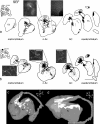

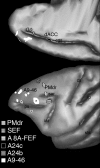

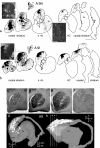

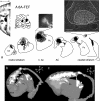

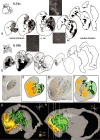


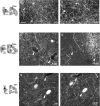
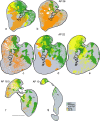
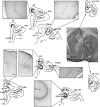
Similar articles
-
Distributed but convergent ordering of corticostriatal projections: analysis of the frontal eye field and the supplementary eye field in the macaque monkey.J Neurosci. 1992 Nov;12(11):4468-88. doi: 10.1523/JNEUROSCI.12-11-04468.1992. J Neurosci. 1992. PMID: 1279139 Free PMC article.
-
Primate cingulostriatal projection: limbic striatal versus sensorimotor striatal input.J Comp Neurol. 1994 Dec 15;350(3):337-56. doi: 10.1002/cne.903500302. J Comp Neurol. 1994. PMID: 7533796
-
Topographical organization of the projections from physiologically identified areas of the motor cortex to the striatum in the rat.Neurosci Res. 1992 Jun;14(1):39-60. doi: 10.1016/s0168-0102(05)80005-7. Neurosci Res. 1992. PMID: 1380687
-
Corticostriatal circuitry.Dialogues Clin Neurosci. 2016 Mar;18(1):7-21. doi: 10.31887/DCNS.2016.18.1/shaber. Dialogues Clin Neurosci. 2016. PMID: 27069376 Free PMC article. Review.
-
The cortico-basal ganglia integrative network: the role of the thalamus.Brain Res Bull. 2009 Feb 16;78(2-3):69-74. doi: 10.1016/j.brainresbull.2008.09.013. Epub 2008 Oct 23. Brain Res Bull. 2009. PMID: 18950692 Free PMC article. Review.
Cited by
-
Convergence of prefrontal and parietal anatomical projections in a connectional hub in the striatum.Neuroimage. 2017 Feb 1;146:821-832. doi: 10.1016/j.neuroimage.2016.09.037. Epub 2016 Sep 17. Neuroimage. 2017. PMID: 27646127 Free PMC article.
-
Relationship of resting brain hyperconnectivity and schizophrenia-like symptoms produced by the NMDA receptor antagonist ketamine in humans.Mol Psychiatry. 2013 Nov;18(11):1199-204. doi: 10.1038/mp.2012.194. Epub 2013 Jan 22. Mol Psychiatry. 2013. PMID: 23337947 Free PMC article.
-
Neurocircuitry of mood disorders.Neuropsychopharmacology. 2010 Jan;35(1):192-216. doi: 10.1038/npp.2009.104. Neuropsychopharmacology. 2010. PMID: 19693001 Free PMC article. Review.
-
The neuropathology of autism.Scientifica (Cairo). 2012;2012:703675. doi: 10.6064/2012/703675. Epub 2012 Dec 19. Scientifica (Cairo). 2012. PMID: 24278731 Free PMC article. Review.
-
Mechanisms of hierarchical reinforcement learning in corticostriatal circuits 1: computational analysis.Cereb Cortex. 2012 Mar;22(3):509-26. doi: 10.1093/cercor/bhr114. Epub 2011 Jun 21. Cereb Cortex. 2012. PMID: 21693490 Free PMC article.
References
-
- Barbas H. Anatomic organization of basoventral and mediodorsal visual recipient prefrontal regions in the Rhesus monkey. J. Comp. Neurol. 1988;276:313–342. - PubMed
-
- Barbas H. Architecture and cortical connections of the prefrontal cortex in the rhesus monkey. In: Chauvel P, Delgado-Escueta AV, editors. Advances in Neurology. New York: Raven Press Ltd.; 1992. pp. 91–115. - PubMed
-
- Barbas H, Pandya DN. Architecture and frontal cortical connections of the premotor cortex (area 6) in the rhesus monkey. J. Comp. Neurol. 1987;256:211–228. - PubMed
-
- Boussaoud D. Attention versus intention in the primate premotor cortex. Neuroimage. 2001;14:S40–S45. - PubMed
-
- Bouyer JJ, Park DH, Joh TH, Pickel VM. Chemical and structural analysis of the relation between cortical inputs and tyrosine hydroxylase-containing terminals in rat neostriatum. Brain Res. 1984;302:267–275. - PubMed
Publication types
MeSH terms
Substances
Grants and funding
LinkOut - more resources
Full Text Sources

